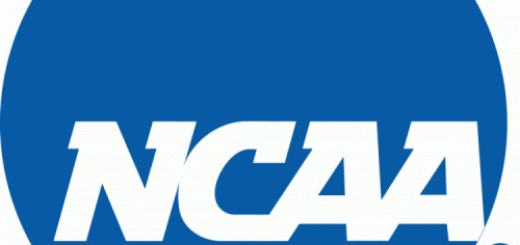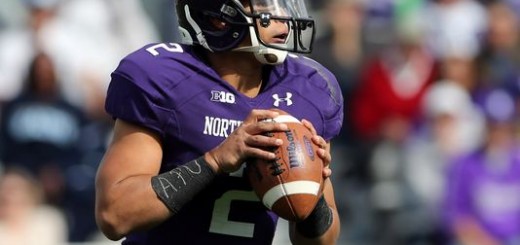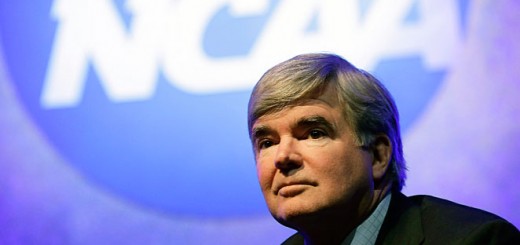If you have two ears and a brain you have probably been in at least one vicious argument over the discussion of whether students who participate in intercollegiate athletics, should be paid (and please note the word choice… these students are already compensated greatly). If you were party to such a discussion hopefully you avoided a thunderdome type battle in which someone lost an arm. To quote Ron Burgundy, those types of discussions “can really escalate quickly…”
And that is exactly the problem with the current discussion on this issue. Everything is sensationalist. Battle lines have been drawn, and nobody seems to want to engage in any sort of rational discussion (I’m looking at you Jay Bilas, http://msn.foxsports.com/collegefootball/story/jay-bilas-goes-on-twitter-rant-against-ncaa-for-making-money-off-players)….The NCAA is currently getting hammered by the public, the media and general cultural zeitgeist. Is this deserved? Perhaps, to an extent.
But it is time for a real unbiased look at how the schools benefit, how the players benefit and the costs to each from the current collegiate sports landscape. Is it fair? is it a violation of human rights on the scale of apartheid? Indentured servitude? Slavery ? There isn’t a good answer to this question yet and there certainly isn’t a consensus….This article and the articles to follow in this series will address this issue as objectively as possible. This first article will simply lay out the landscape of the current climate while subsequent articles will focus on a detailed look at each particular point.
First, a couple caveats. This examination will be devoid of the emotionally charged arguments and rationales that have thus far consumed the debate. Some have argued that many student-athletes don’t care about getting an education and aren’t at the school to learn, as an excuse to say that these same students need additional compensation. http://huff.to/Lh1X8c (Noting that many student athletes lack the skills or motivation to be successful as students as well as a scathing comment from Dominique Foxworth as to the the institution being complicit in this stating “Your challenge is to get them eligible not to educate them”). Unfortunately, this misses the point. College athletics are not there to be whatever the student wants them to be (lets say for example, minor league football). Just because I want to use my plugged in toaster as a place to store my silverware, doesn’t mean that I get to yell at the toaster company when I end up fried. Second, this article encourages everyone to avoid the use of words like sham, exploitation, hypocrisy. That is unless of course you can provide evidence as to why those words are relevant. Yes, college athletics produces revenue (notice how I distinguished that from profit) for schools. No that does not mean (in and of itself) that student-athletes are exploited. Chevron makes a lot more money than universities do off of people working on oil rigs or wells, and nobody is saying that they exploit the people producing the product. To exploit, in the context that people use it with regards to the NCAA, means to make use of, meanly or unfairly for one’s own advantage. So unless you have evidence of unfairness to student-athletes you can go pound sand. Likewise, the NCAA apologists who talk about ideals, and honor, and who use responses like “that’s just how it is” can join the exploitation gang on the beach. Finally, this discussion is going to be limited to the revenue producing sports of football and men’s basketball, since everything else for the most part hemorrhages money faster than the WNBA.
So without further ado, lets lay out the picture and try to define the parameters of the discussion. Each of the items below will get its own column to investigate further.
Benefits Student-Athletes Receive From Playing Sports
The first and most obvious benefit student athletes (“SA”s) receive is the opportunity for higher education. Not only that, but for many SAs this opportunity would not be otherwise available to them but for their athletic prowess. There are many ways to look at the value of this, all of which will be investigated further in future articles. One way is to simply look at the cost of attendance (lets say for the sake of argument 50k per year private, 20k public) and multiply that by four years (scholarships are year to year deals by default, but find me an example of a school really screwing a kid on this and I will give you a high five. Additionally schools can, and many do, offer multi year scholarships now). That’s a somewhat simplistic view. Another view would be to look at it from an opportunity cost perspective. How much does a college degree increase that person’s earning power, versus how much money could that person have made in the same time period doing anything else available (say for example starting their own business, working a job, or training at a sports academy for the same amount of time).
SAs also receive housing. This is pretty straightforward, and can be valued relatively easily SAs may stay in the dorms for free or receive a stipend equal to what is charged to other students to stay wherever the SA chooses (subject to individual university or team rules).
SAs receive their textbooks paid for, and anyone who has been to a college bookstore recently knows that a semesters worth of books can be well over $1000.
Another benefit is instruction from elite level of coaches. In other words, being able to get instruction from someone like coach Krzyzewski or Nick Saban, is worth something, and it’s something that is not generally available. Think of it this way, remove scholarships and talent from the equation and let’s put coaches in a free market. How much do you think you’d have to pay to be one of the 15 people on Duke basketball in a given year? Ten thousand? Fifty Thousand? Either way this is a non-negligible number and a concrete benefit of playing college sports.
A more abstract benefit of being a SA is that the compensation for your time is tax free. In other words the value of a scholarship does not count as income under the current U.S. Tax Code. This may seem small, however going by the value of the scholarship for an out of state player at a private school, the income tax bill would likely be around $10,000. To be fair, this is a benefit shared by all scholarship students not only athletes.
SAs receive a higher level of medical attention than regular students. They have team doctors and trainers to take care of them as opposed to other students waiting in line at student health. Additionally, like all other students, SAs are covered under a health care policy that is either paid for by the student or included in tuition and thus their scholarship.
SAs have the opportunity to train at state of the art facilities at no additional fee. I may pay 100$ a month to not work out at Lifetime Fitness, but what would you say the value of having access to something like this is?
Perhaps the biggest benefit SAs receive is that universities and the NCAA provide them with a forum to ply their craft and develop their brand. Let’s imagine a world without intercollegiate sports. Do you think anyone even knows who Johnny Manziel is in that world? If Johnny Manziel pretends to make it rain but isn’t on TV does it really happen? This benefit is enormous. By the time SAs can go pro, they already have followers and a TV audience and brands big enough to justify huge endorsement contracts. For those of you who would say that a club system like European soccer would provide the same exposure, I’d like to point out to you that nobody watches any of the following competitions: Liga Adelante, Serie B, The Sky Bet Championship , the Pacific Coast League or the NBA DLeague. Americans care about watching the highest level of competition, which makes collegiate athletics somewhat of a paradox. People watch because of many things, amateurism, and school pride being the main two which distinguish collegiate athletics from other sub NFL/NBA leagues. Simply put, collegiate sports provide a forum for exposure which benefits athletes not only from a marketing standpoint, but also from a draft stock/development standpoint that the alternative (training at IMG, playing in the UFL or the DLeague) cannot come close to matching.
SAs receive the opportunity to travel that most other students do not get. Let’s say you get to go to the Sugar Bowl or the NCAA tournament is in New Orleans, you get a free trip to one of the cultural centers of the United States. Not really a concrete benefit I grant you, but definitely a perk.
There may exist other benefits as well ranging from the opportunity to take “extra” benefits (as defined by the NCAA bylaws as illegal) to better campus life.
Benefits Universities or Colleges Receive From Athletics Programs and SAs
Schools also receive huge benefits from intercollegiate athletics. If these benefits were not substantial schools would not continue athletics programs that for the most part lose money year to year. The most talked about advantage schools receive from athletics programs and their SAs is straight cash money. Schools make insane amounts of revenue from college sports, with results on the profit margin being a mixed bag. Schools like Penn State, Wisconsin and Tennessee basically break even across all college sports according to USA today, and that is including subsidies in revenue. This linked Forbes article shows another mixed bag when it comes to football related profit with top 25 schools making a very rough estimated profit between 9 and 45 million per year. However remember that this profit is usually used to subsidize all the non revenue sports the school carries.
Schools benefit by publicity and prestige. Future articles will address further, but admissions numbers go up when athletics teams do well (Gonzaga being a great test case for this) and having an athletics program can be a draw to incoming applicants who view it as a benefit to campus life.
Schools receive gate receipts and in many cases parking money and concessions money from their exhibitions. However, the real money comes through media rights which are generally granted to the conference and subsequently sold to the highest bidder. Schools receive the benefits of merchandising and licensing their brand or logo. Whether the school has its own manufacturing or licenses the brand to outside companies, there can be no doubt that schools have developed brands based in large part on the backs of their athletics programs.
When we are talking about the money that is generated for schools by their athletics programs, it is very important to distinguish revenue dependent on a program versus revenue dependent on a player. Most SAs on their own add zero marginal revenue to the school. In other words if their backup played, it is likely the school would make the same amount of money. Once in a while a transcendent player in an unlikely location comes along to prove this wrong (Robert Griffin III, Jimmer Fredette). But if Braxton Miller’s backup (Kenny Guiton) plays instead of him, I’d like to see how Ohio State University really makes less money. The biggest driver of revenue for schools is tv money. Those contracts are put in to place years in advance. Ohio State will sell the same amount of jerseys, receive the same amount of television revenue, likely be talked about by ESPN the same amount, sell the same amount of tickets, have the same amount of Mark Tituses as alumni, and have the same amount of stupid lower case letters in their acronym (tOSU) (and yes the big 10 network makes this a bit more complicated, and this will be addressed in future articles). On the other hand, having Jameis Winston, probably had Florida State mentioned slightly more in the media (scandal aside), led them to the national title which probably comes with a bigger one time payoff than a BCS or other bowl. Would FSU have done as well with Winston’s backup playing? Perhaps.
Costs to Athletes
SAs also have costs or consequences to participating in intercollegiate athletics for example, the opportunity cost of attendance, or the opportunity cost of playing sports once in the college setting. They also experience a risk of injury which is a cost and a physical cost/toll on their bodies. Perhaps one of the biggest costs is the cost of foregoing years of a professional career (for students who stay through senior year in football or past freshman year in basketball). Professional athletes have 7-10 years if they are very lucky to make most of the money they will need in their lifetime, giving up one of those years to be compensated less while in college is a cost.
Costs to Schools
The most obvious cost is financial. But lets paint a small picture as to just how big of a cost this is. Football stadiums require capital contributions and heavy maintenance. Even a small stadium like the one Tulane is building on campus in an effort to revitalize its football program can cost in excess of 50 million dollars. Training and athletics facilities also require capital contributions and must constantly be updated as schools have now gotten into an arms race over athletics facilities due to the fact that it is a deciding factor for many top recruits. Additionally football programs must pay travel expenses for a small army for 5-7 away football games every year. Athletics equipment for an athletics program is an enormous cost. Additionally, due to title IX, for every dollar spent on football, schools must make that dollar available for women’s programs as well (unless they are complying under the provision of title IX saying they have already met all the women’s athletics interest). The costs to schools of athletics programs are huge, and while the revenue streams are also huge, to all but the top programs, athletics are a financial burden that must be weighed against the benefits of paying for the programs.
Conclusion
So that’s it for this article folks, I’ve simply attempted to lay out the groundwork, and each item will receive its own in depth treatment over the coming months. If and when you figure out that I missed something, feel free to put something in the comments, and we will be sure to take a look at that benefit/cost as well. ESPN and the rest of the “embrace debate” media certainly have rushed in to the sensationalist coverage of the NCAA and issues of whether SAs should be paid. It’s easier that way. Looking at the issue analytically, requires thought and research. However this blog is not afraid to trudge forward and attempt to come up with a well reasoned conclusion.



Interesting perspective. A point to note, and possibly a bit of nit picking….you mention college cost ranging from $20K to $50K and then go on to include books, room and board, etc…. when in fact, in most instances, the $20K to $50K includes those college attendance cost. So, from my perspective, you cannot double count the cost of attending college.
On another more important note, if the colleges are not making money or just breaking even from college football revenue, how on earth did colleges every survive prior to getting TV revenue, and other related sorts of non-alumni revenue. Many schools have had broad collegiate athletic sports programs for decades and were not necessarily drafting off of the revenue from their football and or college basketball revenue. If you look more closely, it is the students, fans and consumers in general that are the ones really being exploited. To see how students are getting exploited, just look at the additional disclosed and not always disclosed add-on tuition expenses / fees. They are generally listed as “Student Activity Fees, Student Athletic Fees, Student Recreational Fees, and other creative naming conventions to extort money from students for college athletic programs. Historically, students attending college athletic program ,in particular football games, did so for free or near free, but now pay a standard / mandatory fee listed or embedded in almost any college tuition. That assumes they even get a ticket, given many schools sparingly dole out student tickets under a lottery program, while the majority of the football or basketball tickets are sold to alumni and businesses for a tidy sum, So, when you really think about it, the ones really doing the exploiting are those running colleges, along with those that run college athletic programs. Even the athletes are in on the act (those on full / partial scholarships along with known / not-known perks and or benefits. they receive…cars, apartments, tutors, and preferential classes). Not to mention the coaches, certainly the media, and others commercially involved in college athletics for monetary gain. One could even include the NCAA, in the exploitation of students and fans, when you really think about it. Have you every looked at how much money they garner and how much power they control in terms of conferences, bowls, and schedules? Certainly a lot of people are in on the act, with plenty of finger pointing to go around.